First Look: Samsung Galaxy S8
by Matt Humrick on April 21, 2017 8:55 AM EST- Posted in
- Smartphones
- Samsung
- Galaxy
- Mobile
- Snapdragon 835
- Galaxy S8
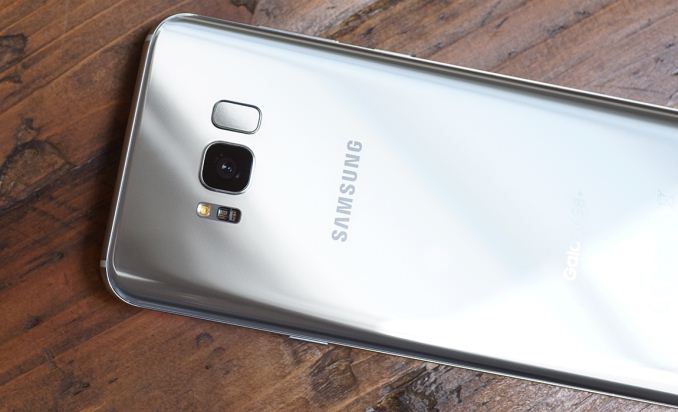
We first saw Samsung’s new 5.8-inch Galaxy S8 and 6.2-inch Galaxy S8+ at its Unpacked event a few weeks ago. During the event, we saw demos of its new virtual assistant, Bixby, and its DeX docking station, which allows the Galaxy S8 to provide a desktop-like experience by connecting to an external monitor and peripherals, but we didn’t have much time with the phones to do much more than take some pictures and try a couple of the new features. After receiving a Galaxy S8 earlier this week, we wanted to give you some feedback about its design and biometric features, as well as, an initial performance and battery life assessment before we dive into our usual in-depth testing.
My biggest complaint about the design is the location of the fingerprint sensor, which I discuss in the video above. It has been relocated to the back next to the camera, making it difficult to reach and use. The new face unlock feature, the second of the S8’s three biometric authentication options, is flawed too. Despite my best efforts, I was not able to get face unlock to work, not even once. The feature, which relies solely on the front-facing camera for identification, also is not very secure, assuming it works at all. It has already been shown that simply holding a picture in front of the camera is enough to fool it into unlocking the phone. The camera really needs to be augmented with an infrared camera to detect a face’s heat signature as a liveness test, or a second, depth-sensing camera to at least detect a face in three dimensions. So far the iris scanner, which I also demo in the video above, has proven to be the easiest and most reliable biometric option.
| Samsung Galaxy S8 Series | ||
| Samsung Galaxy S8 | Samsung Galaxy S8+ | |
| SoC | Qualcomm Snapdragon 835 (US, China, Japan) 4x Kryo 280 Performance @ 2.35GHz 4x Kryo 280 Efficiency @ 1.90GHz Adreno 540 Samsung Exynos 8895 (rest of world) 4x Exynos M2 @ 2.30GHz 4x Cortex-A53 @ 1.70GHz ARM Mali-G71 |
|
| Display | 5.8-inch 2960x1440 (18.5:9) SAMOLED (curved edges) |
6.2-inch 2960x1440 (18.5:9) SAMOLED (curved edges) |
| Dimensions | 148.9 x 68.1 x 8.0 mm 155 grams |
159.5 x 73.4 x 8.1 mm 173 grams |
| RAM | 4GB LPDDR4 (US) | |
| NAND | 64GB (UFS) + microSD |
|
| Battery | 3000 mAh (11.55 Wh) non-replaceable |
3500 mAh (13.48 Wh) non-replaceable |
| Front Camera | 8MP, f/1.7, Contrast AF | |
| Rear Camera | 12MP, 1.4µm pixels, f/1.7, dual-pixel PDAF, OIS, auto HDR, LED flash | |
| Modem | Snapdragon X16 LTE (Integrated) 2G / 3G / 4G LTE (Category 16/13) Samsung LTE (Integrated) 2G / 3G / 4G LTE (Category 16/13) |
|
| SIM Size | NanoSIM | |
| Wireless | 802.11a/b/g/n/ac 2x2 MU-MIMO, BT 5.0 LE, NFC, GPS/Glonass/Galileo/BDS | |
| Connectivity | USB Type-C, 3.5mm headset | |
| Features | fingerprint sensor, heart-rate sensor, iris scanner, face unlock, fast charging (Qualcomm QC 2.0 or Adaptive Fast Charging), wireless charging (WPC & PMA), IP68, Mobile HDR Premium | |
| Launch OS | Android 7.0 with TouchWiz | |
Inside the redesigned Galaxy S8 and S8+ is either a Qualcomm Snapdragon 835 or Samsung Exynos 8895 SoC. The US and other regions that require CDMA capability will get the Snapdragon 835, while the rest of the world will get Samsung’s SoC. The new 10nm SoCs are paired with 4GB of LPDDR4 RAM and 64GB of UFS 2.1 NAND. The Galaxy S8 comes with a 3000mAh battery, the same size as the Galaxy S7, while the S8+ comes with a 3500mAh battery, slightly less than the S7 edge’s 3600mAh capacity.
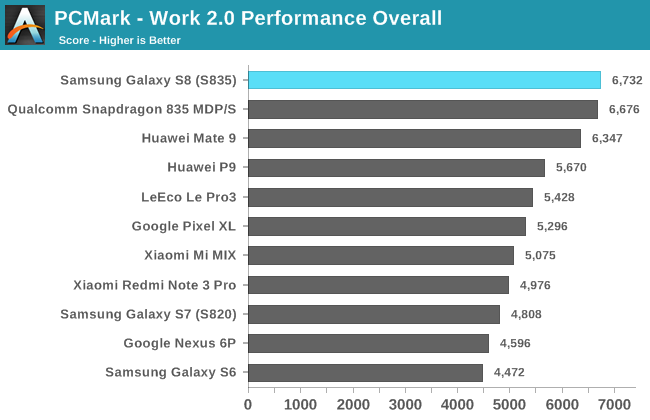
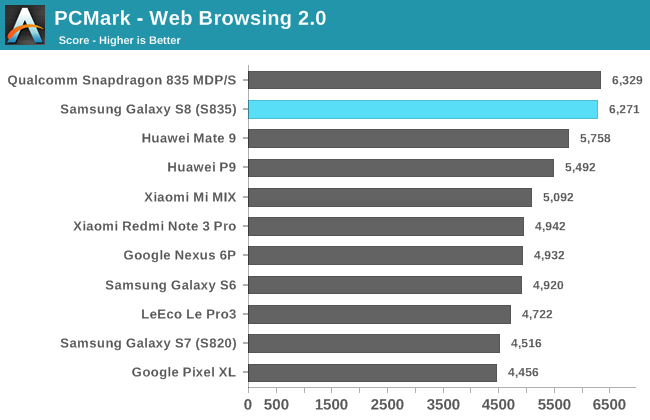
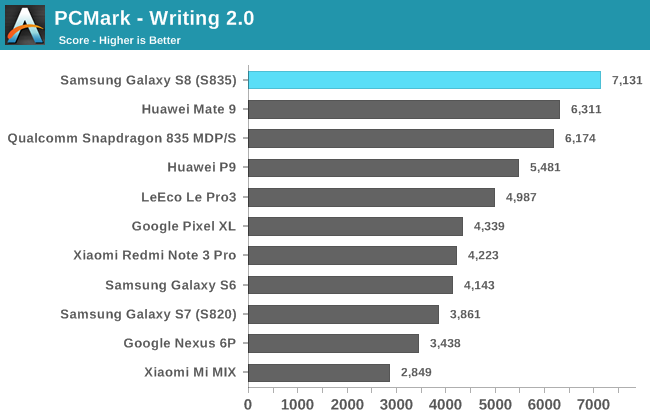
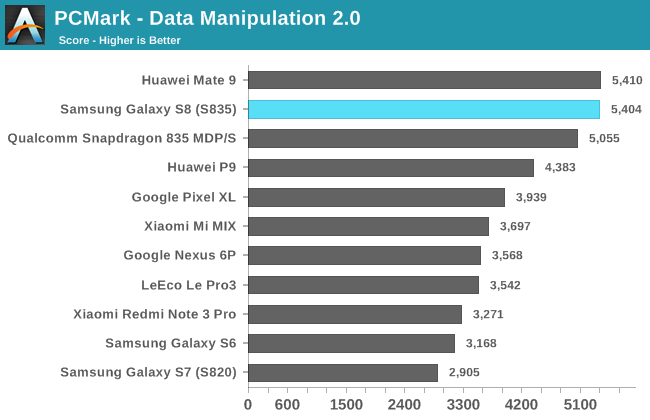
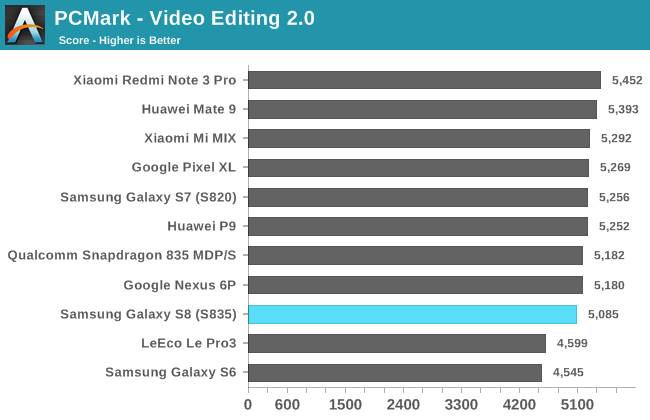
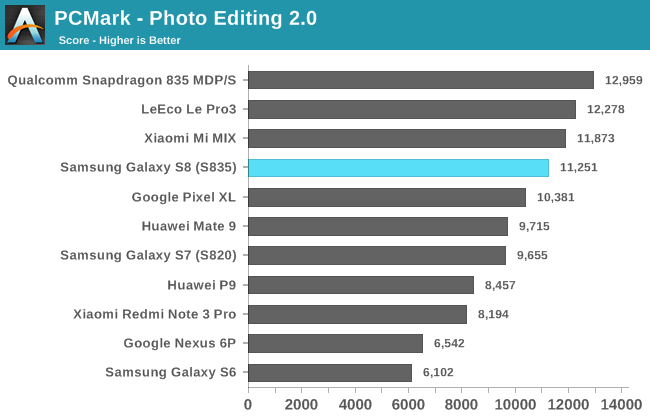
In PCMark, which is our best indicator of general system performance, the Galaxy S8 with Snapdragon 835 performs quite well, besting even the Mate 9 overall. Because this is the first S835 retail device we’ve tested, I’ve also included Qualcomm’s Snapdragon 835 MDP/S, which the company uses internally for hardware testing and software development, as a reference point. In most of these tests, the Galaxy S8 performs about the same as the Snapdragon 835 MDP/S, which is certainly a good sign.
The Galaxy S8 does particularly well in the Writing test, outscoring the Mate 9 by 13% and the Galaxy S7 (Snapdragon 820) by 85%. The Writing test, which previous Galaxy phones struggle with, uses a fairly bursty workload, frequently migrating threads between the little and big cores. Perhaps this is an indication that Samsung is utilizing the big cores more aggressively than in the past. The Galaxy S8 is also 9% faster than the Mate 9 in the Web Browsing test and 37% faster than the S7 (S820).

The Galaxy S8 achieves over 8 hours of screen-on-time while continuously crunching through the PCMark workloads, 46% longer than the Galaxy S7 that has the same 3000mAh battery, which suggests some nice efficiency gains from the new SoC, display, or other components. While the Galaxy S7 can struggle to last a full day on a single charge depending on how it’s used, these initial results suggest the Galaxy S8 will encounter fewer scenarios where it will need to use its fast charging or wireless charging abilities to stretch battery life till the end of the day.
While we’ve only had the Galaxy S8 for a couple of days, our first impression is generally positive. It’s packed with features, TouchWiz is more refined, and it performed well in our first performance and battery life tests. A few issues are already apparent, however. Your face probably will not be smiling if you try to rely on it to unlock the phone, and the fingerprint sensor is located in just about the worst possible place. Samsung’s Bixby assistant also is not yet fully functional; fortunately, you can still use Google Assistant while you’re waiting for Bixby to mature.










129 Comments
View All Comments
tuxRoller - Friday, April 21, 2017 - link
That seems somewhat uncertain as Samsung tends to not integrate Snapdragon as well as some other companies.I'm curious as to what is happening with the photo editing test. That's quite a divergence from the reference hardware, which it otherwise tracks closely.
Eden-K121D - Friday, April 21, 2017 - link
Galaxy S8 is a very small upgrade from the S7 overall except for the display.Also Matt did you test the battery in default mode with FHD+ resolution or the WQHD+ with performance mode
Matt Humrick - Friday, April 21, 2017 - link
I ran this test with default settings (Optimized, FHD+). I'll test with WQHD+ also in our full report.lilmoe - Friday, April 21, 2017 - link
Please keep it at the default FHD+ resolution for your in depth analysis. The battery/performance gains in browsing, gaming, and other UI navigation is pretty darn significant, even on my GS7e (which, after the latest update, was running FHD+ by default as well). And while CPU efficiency gains for video streaming isn't as significant (since it's fixed function decoding), the bandwidth saved from streaming lower resolution files (FHD vs QHD) are significant and contribute more to battery life than the CPU.I believe this is very critical, since it portrays a truer, real world image of the device performance for the average user (which gets FHD+ by default, and will probably leave it at that). But I'm also interested to see your take on the difference.
Oh, and please, PLEASE try to get your hands on the Exynos variant. It would be really nice to see a head-to-head deep dive of the different SoCs.
gigathlete - Friday, April 21, 2017 - link
Hi Matt, is the letter boxing while playing 16:9 videos or using apps annoying?gigathlete - Friday, April 21, 2017 - link
Also when you test battery life can you try to make sure there is no letter boxing? Having part of the screen off would not be a good representation of total power usage. Thank you.Matt Humrick - Friday, April 21, 2017 - link
I do not find the letter boxing annoying. The black bars are on the left and right sides of the video, and, at least in the YouTube app, there's a hidden button to crop the video and play it full screen.lilmoe - Friday, April 21, 2017 - link
"Galaxy S8 is a very small upgrade from the S7 overall except for the display"No it's not. It's a fairly significant upgrade, especially for US customers.
- The design and display thing is pretty obvious, and very significant.
- The processor is a huge step up from last year's SD820 in terms of process and better, much more efficient load distribution (more cores). Looks like Qualcomm has significantly improved their image processing blocks this time (not exactly Exynos levels, but much better than last year). The Exynos model sees a slightly less significant upgrade, but surely not insignificant (especially in image processing and video encoding/decoding).
- UFS 2.1 is a HUGE upgrade in storage performance, which actually matters in both speed and general power efficiency.
- Much better, 32bit audio processing and output, especially for the US models.
- The battery has a much improved life span (has to be tested though).
Not sure what people are expecting. Other than some blemishes (like the fingerprint sensor placement, which isn't a deal breaker by any means), the GS8 will most probably be the best flagship of 2017, only bested by the Note 8, as tradition has it.
The default resolution of FHD/FHD+ in Samsung's latest implementation is a revelation. After so much LOUD nagging from myself and numerous sensible users, they've FINALLY allowed us to change the screen resolution. QHD or higher on this screen size is simply pointless, if you can see a difference, then you're only one of a handful of users, and you still can change it back. But just look at the battery life gains.... Who wouldn't want better battery life and optimal performance for a MOBILE device???
I'm not sure why everyone is asking reviewers to set the screen resolution to max. They shouldn't, because that's what everyone's getting. And no, I don't believe it's a downgrade, you still get the BEST display in the business and the sharpest FHD screen (since there's more than 3 sub-pixles per pixel), while still enjoying the best screen characteristics (brightness, color accuracy, HDR, infinite contrast, etc...)
Here's the thing. Galaxies only get better, faster and smoother with each major update, the most significant lately was the new Grace UX (or Samsung Experience like they like to call it). The lower screen resolution has contributed greatly to that. Some people say that they get sluggish over time (warranting a factory reset), but that's a thing of Android that Google needs to fix, in addition with irresponsible user habits (which Samsung sort-of remedies with the latest update in the form of Device maintenance in the settings menu).
Meteor2 - Friday, April 21, 2017 - link
I hope Google release something decent.lmcd - Friday, April 21, 2017 - link
They're tied to HTC's release schedule.I hope Google never releases a phone again, or buys HTC and gives them the brand backing they deserve.